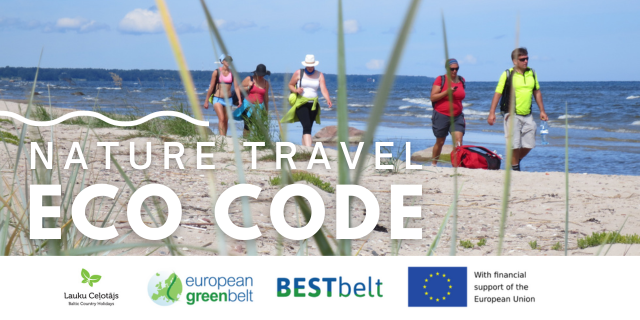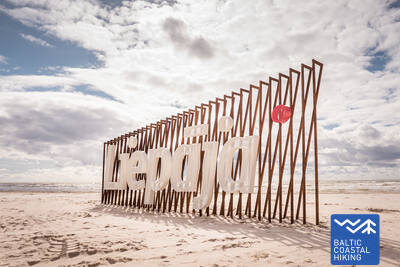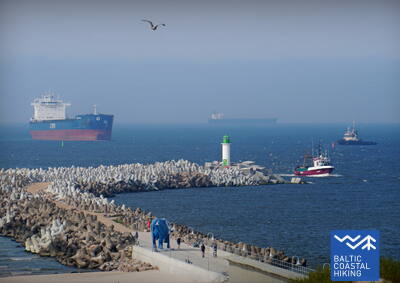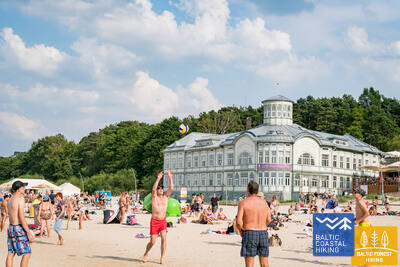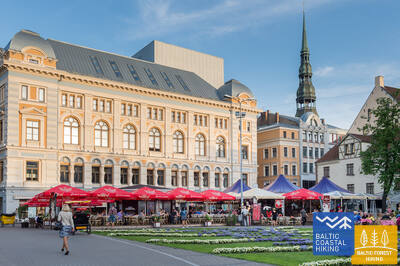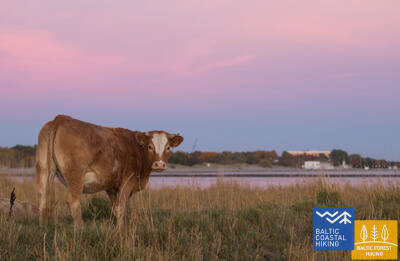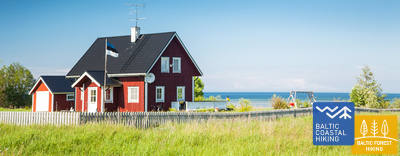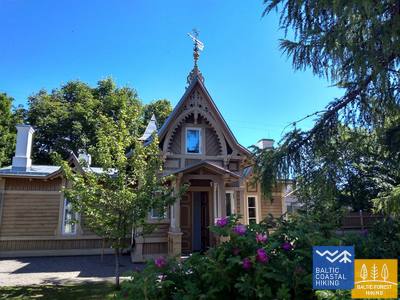Baltic Coastal Hiking trail - Cultural experience
 Section 3. Bernāti - Liepāja - Karosta (The War Port).
Section 3. Bernāti - Liepāja - Karosta (The War Port).
The City Where The Wind Is Born
From Bernāti to Liepāja, the Baltic Coastal Hiking Route leads through a wide beach where initially the coast is formed by washed away shores, but as you approach Liepāja high foredunes covered in sand ryegrass and marram grass appear in sight. Later the trail winds through the old town of Liepāja and “New Liepāja”, crossing the Naval Port Canal to reach the Naval Port: a complex of military and fortification buildings the visitation of which is likely to take a half day. You should certainly try the special dish of Liepāja called Liepājas menciņi made of smoked cod according to an ancient recipe from Southern Kurzeme.
Liepāja is the largest city in the region of Kurzeme and the third largest city in Latvia. It features an old town, numerous historical and contemporary cultural monuments, and events, as well as a city market. The city offers a wide range of food and drink options in its dining establishments and restaurants, including the city's special dish, "Menciņi," made from Atlantic cod.
 Section 10. Ventspils - Staldzene.
Section 10. Ventspils - Staldzene.
Through Ventspils
The itinerary goes through Ventspils and its surrounding forests. The Baltic Coastal Hiking Route winds from the South Pier through the historic Ostgals and the Old Town, crosses the Venta River and continues through the Pārventa District via a pedestrian and cyclist path in the direction of Staldzene where it circles the Ventspils Port and then returns to the seacoast. It is worth taking one “day off” and get to know the most interesting places in the city, as well as visit the Seaside Open-Air Museum.
 Section 14. Sīkrags - Saunags.
Section 14. Sīkrags - Saunags.
The Livonian Coast
A wide sandy beach stretches from Sīkrags village up to Mazirbe beach which is crossed by the Mazirbe Stream. The Baltic Coastal Hiking Route leads out to the center of Mazirbe village where you can see the Livonian National House. Continuing through small forest and country roads past the former Mazirbe Naval school, it winds through small coastal Livonian villages: Košrags, Pitrags and then Saunags. The Livonian Coastline is the only place where you can learn about the cultural heritage of the other indigenous nation of Latvia. In this section, the indicating signs are in both the Latvian and Livonian language.
One of the most densely populated sections of the Livonian Coast, featuring Livonian fishing villages such as Sīkrags, Mazirbe, Košrags, Pitrags, and Saunags. The material and intangible heritage of the Livonian people can be explored here. The Jūrtaka trail between Mazirbe and Saunags follows the old, historic coastal road, offering excellent views of the villages and their architecture.
 Section 22. Dubulti - Lielupe - Bulduri.
Section 22. Dubulti - Lielupe - Bulduri.
The Most Popular Beaches in Latvia
The widest sandy beach of the Gulf of Riga stretches from Dubulti to the Lielupe River. It is the main asset of the Jūrmala resort offering many beach cafés and different recreational possibilities. The coastal dune forests are permeated with a dense web of trails suitable for walking and stick-walking. The part of the Baltic Coastal Hiking Route located between the beach of the Lielupe River and Jūrmala beach is part of the Ragakāpa Nature Park. From here, you can easily get back to Bulduri by taking Bulduri prospekts and the 5th line.
The Jūrmala resort has a long-standing tradition in health and wellness tourism. The city's historic wooden architecture and its unique elements are particularly interesting. Numerous historical and contemporary landmarks can be visited, including museums, memorial sites, Jomas Street, and the historic parts of Jūrmala. The Dzintari Concert Hall is a popular venue for events.
 Section 24. Riga City Center - Vecāķi.
Section 24. Riga City Center - Vecāķi.
Riga Old Town – a UNESCO World Heritage site
Initially, the itinerary takes you on a small stroll around Riga City Center, Riga Old Town, leads along the City Canal through Kronvalds Park, via Alberta iela (Art Nouveau buildings) and further on via Miera iela through the Lielie kapi Cemetery, via Kokneses and Ostas prospekts through Mežaparks and then it reaches Jaunmīlgrāvis and crosses Mīlgrāvis . Then it meanders along Vecāķu prospekts up to Ziemeļblāzma and the banks of the Old Daugava River (Vecdaugava) separated by only a couple of kilometers from Vecāķi. After a two-day hike through Riga, the Baltic Coastal Hiking Route leads you out to the beach again.
Riga's historic center is a UNESCO World Heritage site, boasting a rich array of cultural monuments. Riga is the city with the highest concentration of museums, exhibitions, and various annual events. It also offers the widest selection of dining establishments and restaurants, including traditional Latvian cuisine. Additionally, there are souvenirs and events related to national and other cultural traditions.
 Section 26. Carnikava - Saulkrasti.
Section 26. Carnikava - Saulkrasti.
The Sunset Trail With Romantic Sunset Vistas
Initially, the itinerary leads you through the Gauja River levees in Gauja village reaching the estuary of the Gauja River, which is a good place for bird watching. The hike continues along a sandy beach up to the estuary of the Inčupe River, before which you have to turn inland to get to a bridge and to cover the next couple of kilometers across the wooded dune tops of the Sunset Trail with a view of the beach. After crossing the Pēterupe River (cable bridge), the Baltic Coastal Hiking Route continues along the beach and reaches the Sea Park in Saulkrasti.
 Section 34. Uulu - Pärnu.
Section 34. Uulu - Pärnu.
Along the Wetlands to Pärnu
First, the Baltic Coastal Hiking Route takes the old coastal roads surrounded by pine forests, but after passing Lottemaa Park it turns towards the sea and comes out at Reiu beach. Next, the hike continues across an overgrown beach (wide shoals when the winds create an outflow of water) and after a little less than 4 km you have to turn inland, cross a golf course and turn in the direction of Pärnu. Near the Raeküla district, it snakes along a small trail forming the border between the large coastal wetland and the forest. Having looped around the wetland for ~ 6 km, the Baltic Coastal Hiking Route emerges at Pärnu beach. Further on, the road goes through the western part of Pärnu Old Town, crosses the Pärnu River and the Sauga River and ends in the Vana-Pärnu district.
 Section 35. Pärnu - Liu.
Section 35. Pärnu - Liu.
The Most Beautiful Views of Pärnu Bay and Smoked Fish
The Baltic Coastal Hiking Route meanders on the outskirts of the west of Pärnu, crosses the Audru River and turns towards Valgeranna, the southern side of which is surrounded by a thick forest and a white sandy beach, while to the north you will find a golf course. After passing Valgeranna, the Baltic Coastal Hiking Route advances between the polders across the northern part of Pärnu Bay. From the Audru polders you will see the most spectacular views of Pärnu Bay. After Audru reeds, the Baltic Coastal Hiking Route turns south and leads through coastal fishing villages with small ports and berths. Here you can see the daily life of fishermen and if you are lucky, then also taste smoked fish.
 Section 37. Munalaid - Tõstamaa.
Section 37. Munalaid - Tõstamaa.
Pastures, Forests and Coastal Meadows
Wetlands stretch across this section of the seacoast, so the sea is only accessible in a few places. Starting from Munalaid Harbour, the Baltic Coastal Hiking Route winds through Lao village and continues along the roadside up to Tõstamaa. The first exit to the sea is to the south of Seliste, the second one is near the Port of Värati (on the way to Värati there are beautiful coastal meadow landscapes with cattle), while the third one is located in Suti village.
 Section 48. Rohuküla - Haapsalu - Uuemõisa.
Section 48. Rohuküla - Haapsalu - Uuemõisa.
The Most Popular Resort in Estonia - Haapsalu
A multifarious section of the Baltic Coastal Hiking Route. The first three kilometres of the itinerary go along the former Haapsalu – Rohuküla broad-gauge railway line, takes you on a stroll along Haapsalu Bay through Pullapää cape, crosses coastal forests, which contain health trails, and continues via coastal promenades and small streets around Haapsalu Town. After crossing a small wetland beyond the town, this section of the trail ends in the beautiful Uuemõisa Park.
Haapsalu resort town is a place to explore industrial heritage (narrow-gauge, broad-gauge railways, rolling stock, museum), military heritage (Kiltsi airfield), historic buildings of the resort town, parks, monuments, medical institutions, etc. Here is one of the most impressive medieval castles in Estonia - a popular venue for annual cultural events. In coastal taverns, you can taste traditional Estonian dishes.
 Section 50. Österby - Riguldi.
Section 50. Österby - Riguldi.
Noarootsi - The Swedish-like peninsula
The Baltic Coastal Hiking Route leads you to the unusual Noarootsi Peninsula where the Swedish have been linked with shaping the cultural environment. The Noarootsi Peninsula is an excellent site for birdwatching in Estonia. The itinerary leads you through Österby, Pürksi, Hosby and Hara villages, in which you will see different kinds of buildings surrounded by fences. In the north of the peninsula, the trail bypasses the overgrown Vööla meri Lake that has once separated from the sea as a bay. Near the shallow Hara Bay, you can see picturesque landscapes with vast reedy areas, coastal juniper meadows and cattle.
 Section 54. Vihterpalu - Padise.
Section 54. Vihterpalu - Padise.
A Seven Centuries Old Church and Monastery
The south shore of the Kurkse Strait is covered in wetlands, so the Baltic Coastal Hiking Route turns inland. The greatest part of the Baltic Coastal Hiking Route leads you through large, sparsely inhabited tracts of forest (corresponding with the trail created by the Estonian State Forest Management Centre: Peraküla – Aegviidu – Ähijärve) and sometimes takes you to a more open space or a village.
Although the Coastal trail mainly leads through a larger forest massif, significant cultural monuments can be explored at its start and finish points and in the middle section - Vihterpalu and Padise manors, Harju-Risti church, and Padise monastery, which is a popular venue for concerts and other events.
 Section 55. Padise - Paldiski.
Section 55. Padise - Paldiski.
Paldiski: The Former Closed and Top Secret Town
Starting from Padise up to Karilepa, the Baltic Coastal Hiking Route winds through small country roads, while further on to Madise it goes along the side of the road. From the ancient seacoast of the Madise church hill, you will have magnificent views of Paldiski Bay and the Pakri Islands. From Madise to Paldiski, the itinerary continues along the side of the abovementioned road up to the South Harbour and, by going along it, the route reaches the railway station located in the southern part of Paldiski. During Soviet times, Paldiski was a closed town with a military port and a nearby nuclear submarine training base at the Pakri Peninsula that operated using a small nuclear reactor.
 Section 58. Laulasmaa - Vääna-Jõesuu.
Section 58. Laulasmaa - Vääna-Jõesuu.
The Most Beautiful Waterfall in Estonia
A multifaceted section of the Baltic Coastal Hiking Route in terms of landscape that is suitable for hardy hikers. There are both rocky and sandy beaches and good swimming areas, fascinating coastal pine forests, the astounding Türisalu Cliff wall and giant sea boulders. By taking the trails of the vast Keila forest park, you can go to the Keila waterfall, near which some fragments of the popular Latvian feature film Vella kalpi (Devil’s servants) were shot, and you can also get to know the exhibition dedicated to the life of coastal fishermen in Lohusalu village.
 Section 60. Tabasalu - Tallinna sadam.
Section 60. Tabasalu - Tallinna sadam.
Tallinn – A UNESCO World Heritage Site
Near Tabasalu, the Baltic Coastal Hiking Route crosses the boundary of Tallinn and goes through the Tiskre and Vismeistri districts to reach Kakumäe beach, where it takes you on a stroll around the wooded upper part of the Kakumäe Peninsula surrounded by cliffs. Here, you will have a vista of the Port of Tallinn across Kopli Bay. Opposite the Õismäe district, an excellent promenade goes along the seashore. After bypassing the Estonian Open-Air Museum, the Baltic Coastal Hiking Route winds along the coastal promenade up to Stroomi beach and after passing the Pelguranna district it takes pedestrian sidewalks to the Estonian Maritime Museum, where it leads you, via the coastal promenade, to the Port of Tallinn, marking the end of the Baltic Coastal Hiking Route. You have covered ~ 620 km in Estonia.
 Section 64. Nida – Pervalka.
Section 64. Nida – Pervalka.
Along the coast of the Curonian Lagoon
The Baltic Coastal Hiking Route starts in the center of Nida, by the port. In Nida, the trail winds along the Curonian Lagoon walkway which offers beautiful views of the expansive waters all the way to Rusnė Island on the east coast of the Curonian Lagoon. Nida features the typical architecture of the Curonian Spit region — one-storey wooden buildings with tile or reed roofs and window shutters painted blue and white. From Nida to Bulvikis Cape (shortly before the cape there is an abandoned runway), the Baltic Coastal Hiking Route winds through single-track forest trails up and down the pine-covered dunes, occasionally coming out onto beachside meadows with scarce vegetation. Rest spots and bird watching towers are available along the trail. The next section features unique open seaside meadows covered in lichens and vegetation characteristic to the Curonian Spit. The Baltic Coastal Hiking Route follows the coastal walkway in the village of Preila. It then winds through forest trails, briefly also following a pedestrian/cyclist lane and coastal paths, eventually reaching Pervalka. This section leads through the Curonian Spit National Park.
Historically inhabited places of the Curonian Spit (Kuršių nerija) include Nida, which boasts many cultural monuments (including museums, exhibitions, and Kuršiai cemeteries), as well as Preila and Pervalka, and the dunes that buried inhabited areas in previous centuries. Fishing traditions and smoked fish.
 Section 68. Palanga – Latvia-Lithuania border (Šventoji).
Section 68. Palanga – Latvia-Lithuania border (Šventoji).
Through the most popular seaside resorts of Lithuania
Having crossed the small Rąžė River, the Baltic Coastal Hiking Route follows the Labrytys pedestrian/runners’ lane and exits out onto the beach at Kontininkų Street. For the next 9 km to the old Šventoji Pier, the trail leads across the sandy, sea-washed beach. Then it loops around the mouth of the Šventoji River, leads through the resort town, and at the end of Kopų Street it crosses the Šventoji River over a hanging footbridge to come back out onto the beach. At the Žemaičių Alka parking lot, the Baltic Coastal Hiking Route makes another small loop “inland” and then follows the sandy beach to the Latvia-Lithuania border 3 km away.
 Section 70. Rusnė – Šilutė.
Section 70. Rusnė – Šilutė.
Šilutė – a charming authentic town
In the Village of Rusnė, the Baltic Coastal Hiking Route follows Taikos Street and Kuršmarių Street, crossing the Atmata River, a distributary of the Nemunas Delta, over the Rusnė Bridge. Then the trail follows the side of the road as a separate lane, continuing on to Šilutė. Shortly before reaching Šilutė, hikers will have to walk on the side of the road. In Šilutė, you will cross the historical bridge over the Šyša River. Rusnė Street, which connects Rusnė Island and Šilutė, brings you right into the center of the town. Up until Šilutė, the Baltic Coastal Hiking Route leads through the Nemunas Delta Regional Park where vast areas of the lower reaches of the Nemunas River flood in springtime — today these areas are agricultural land and swamp forests (Žalgiriai Forest).










